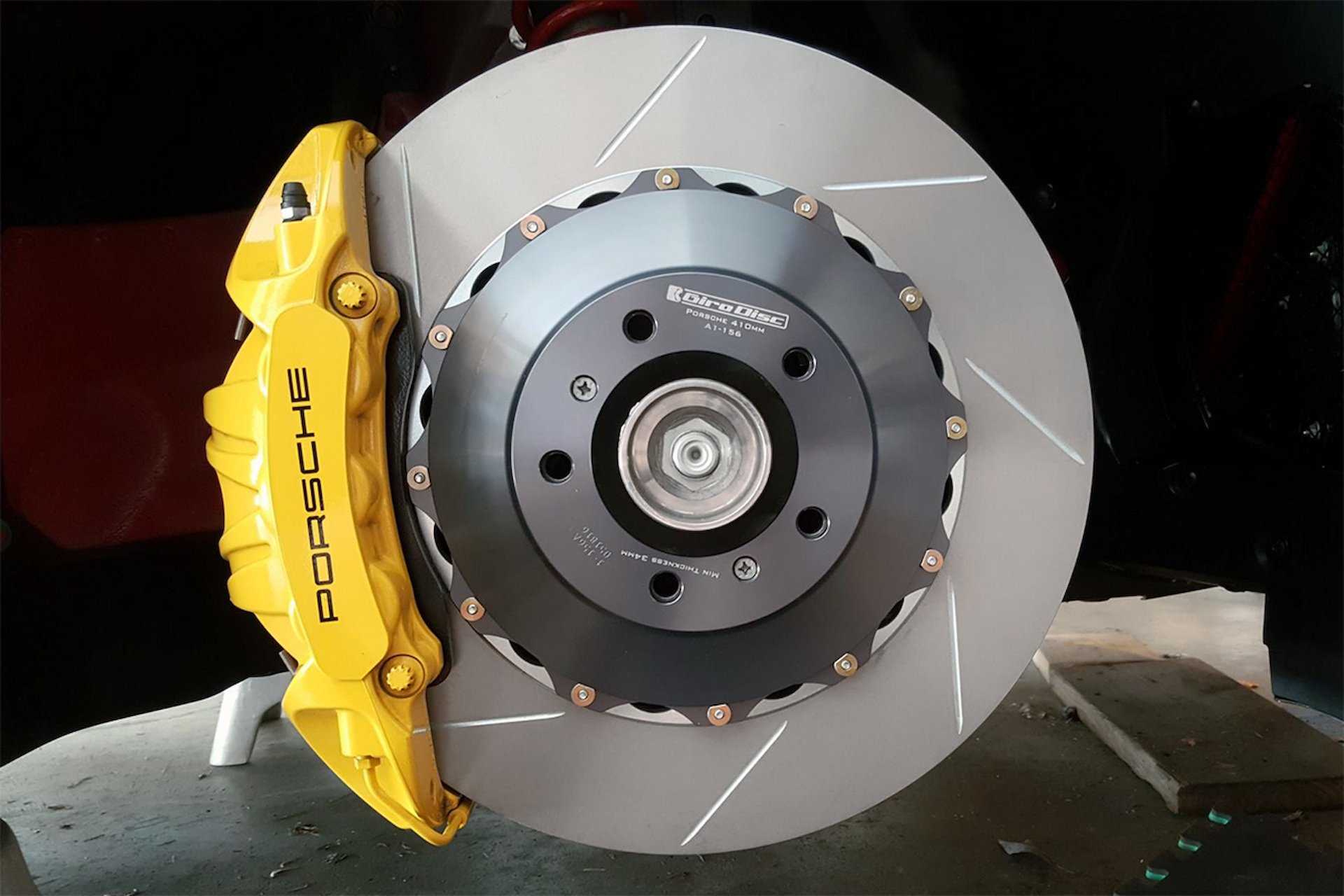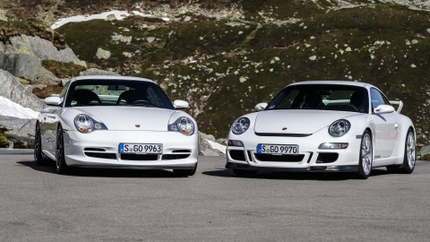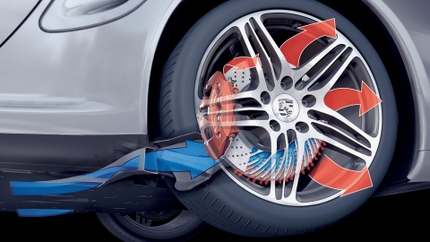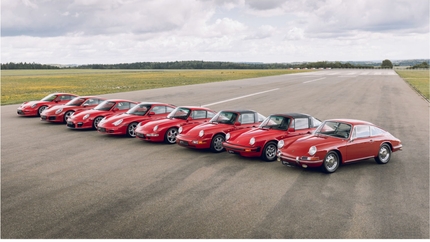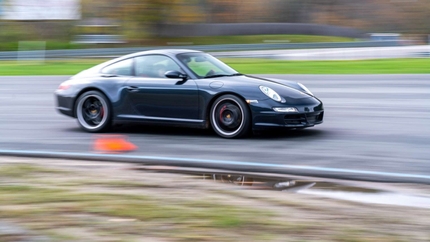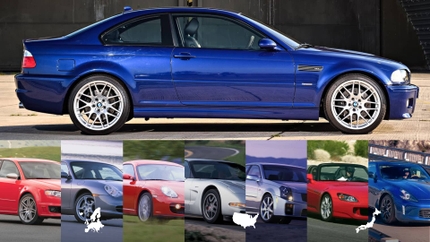- 01/25/2024
- 13 Min Read
- By: Christian Schaefer
The Definitive Guide To The Porsche 997 Brakes
The Porsche 997 911 has fifteen engine and nine manual transmission variants across its generation. The braking system, while slightly less complicated, also features plenty of variance in true Porsche fashion. Calipers are six-piston or four-piston, the rotors are steel or carbon-ceramic, and the caliper color depends on the model. Trying to figure out what brakes you have and which ones you can swap to is tough to decipher from forum searching, so we’re here to simplify all that. Here’s everything you need to know about Porsche 997 brakes.
Porsche 997 Brake System Overview
Porsche’s braking approach evolved with the 997. As the car grew, so did the rotor diameters and piston counts. However, beyond size, it’s all very much the same. Fixed four-piston calipers clamp down on drilled steel rotors at all four corners on all models below the Turbo, with engine displacement determining size and color. The GT and Turbo models sport larger six-piston front calipers over two possible rotor sizes and materials. One of the latter is ceramic composite, equipped with Porsche’s PCCB option. Sporting yellow calipers and dark grey rotors, they’re lightweight, incredibly durable, and incredibly expensive to maintain.
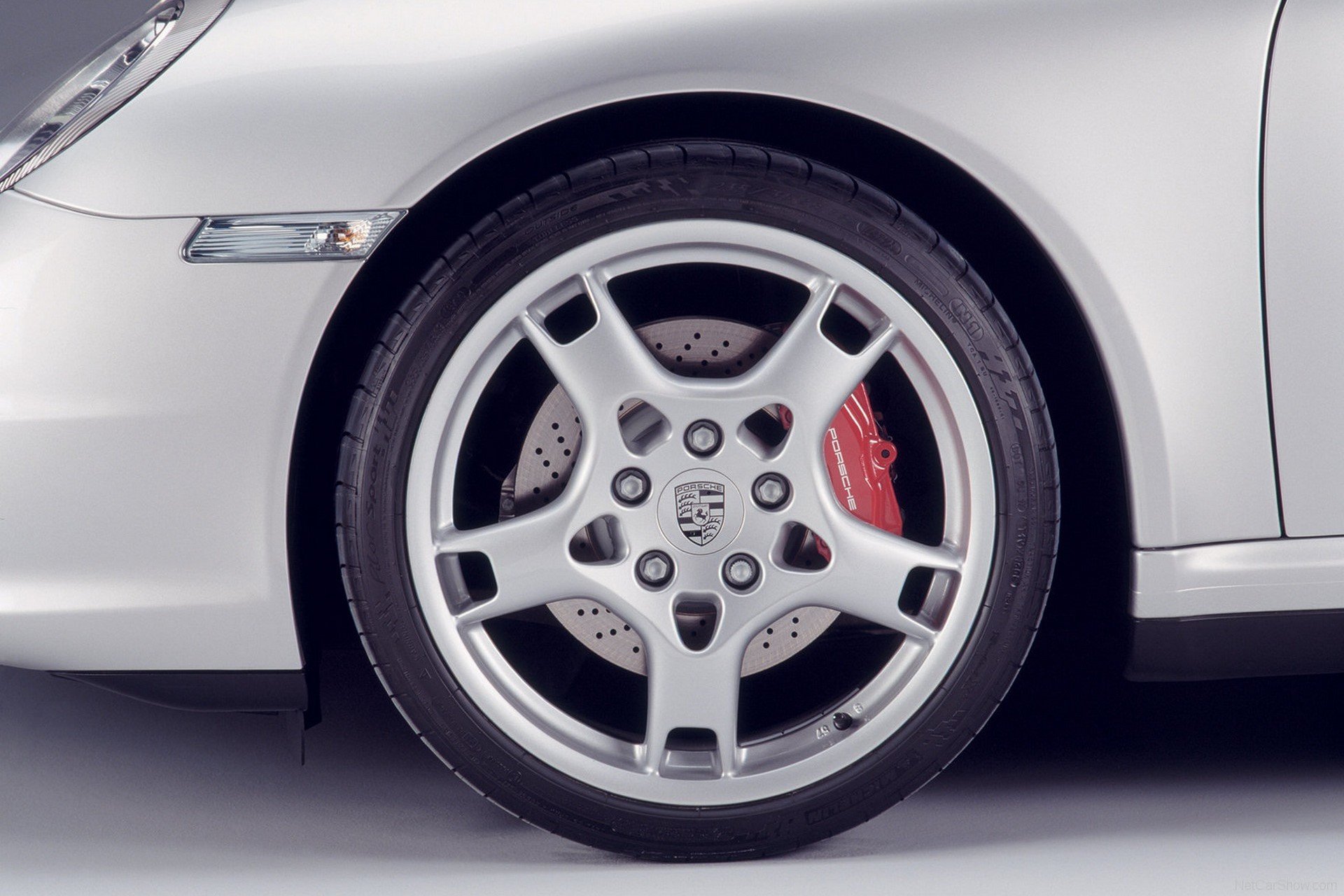
Beyond that, the brake specifics get tricky as Porsche tailored each brake package to the model’s purpose. The GT2 variants and the Turbo were the most consistent, retaining the same package throughout the generation. Carrera models were almost consistent, with the .1 non-S models being the smallest of the 997 and the Carrera’s only outlier. The facelifted .2 models all shared the 330mm size of the .1 S models, but the .2 S received a reinforced caliper with a larger pad. Early GT3 models shared most of the sizing with the Turbo but sported a slightly different caliper and rotor offset. Late GT3s saw sizing jump to PCCB dimensions. The 997 Turbo S and GT2s use the PCCBs as standard, as identified by the yellow calipers. They were also an option on all other 997 models, but the package was close to the $8000 mark, making it a relatively rare option.
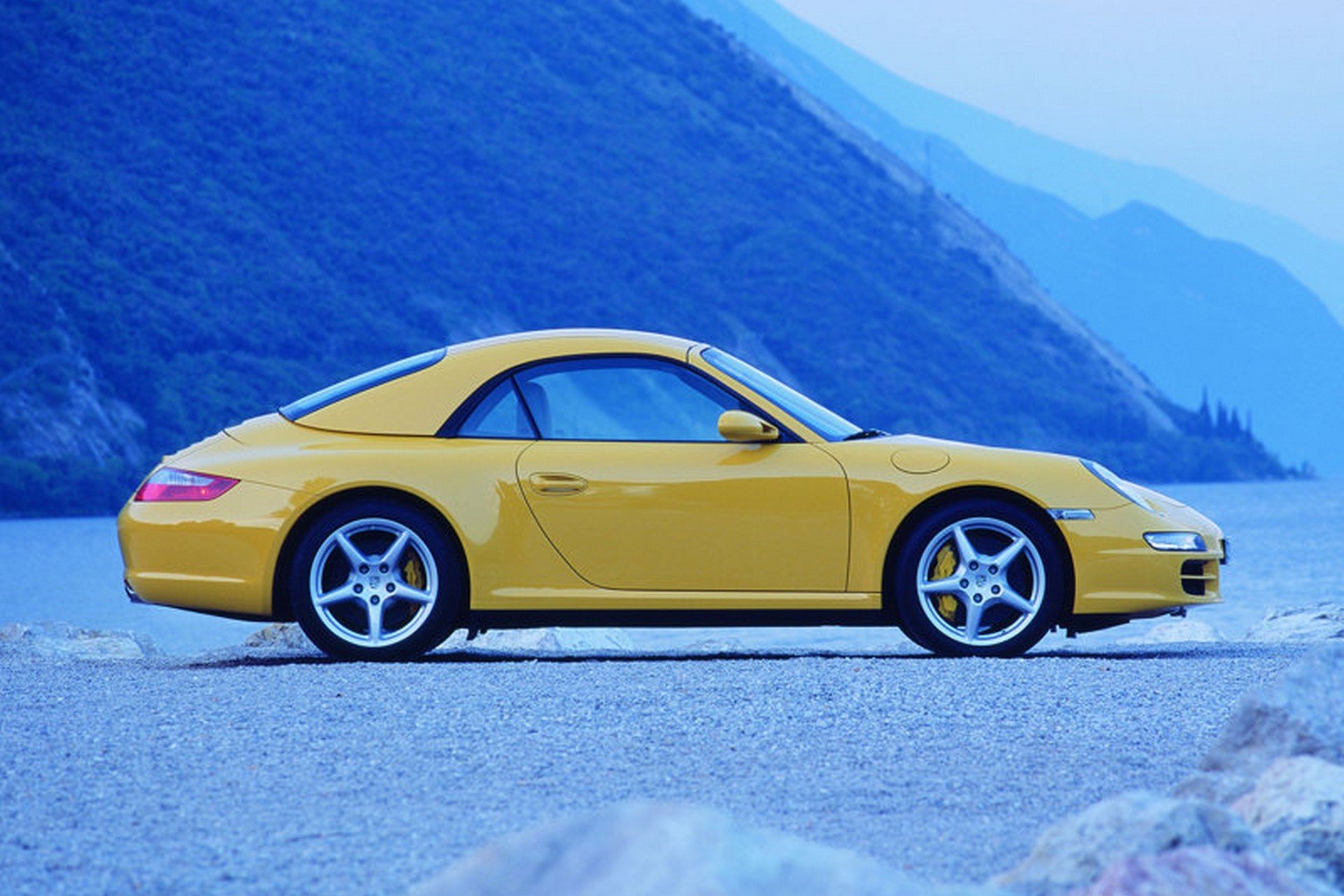
The 997’s popularity in motorsports has also sprouted a significant aftermarket presence focusing on upgrades. Track-capable components vary in intensity and performance, with many well-known companies offering their version of the best product. That said, there’s an opportunity for improvement from within the Porsche catalog, as certain models can be retrofitted with larger OE brake packages with some help from aftermarket adapters. Other upgrades like brake ducting shields and master cylinders are more universal and make an excellent improvement for track use.
How To Identify Porsche 997 Calipers Via Color
Carrera, Carera 4, Targa 4 - Black-anodized Calipers
Carrera S, Carrera 4S, Targa 4S, GTS, & 4 GTS - Red Calipers
Turbo, GT3, GT3RS - Red Calipers (6-piston)
GT2, GT2RS, & PCCB - Yellow Calipers
Carrera Black Edition - Black-painted Calipers
Turbo S 918 Spyder Edition - Acid Green Calipers
Porsche 997 Brake Specifications
Porsche 997.1 Specs |
||||
| Model | Carrera, Carrera 4, Targa 4 | Carrera S, C4S, Targa 4S | Turbo, GT3, GT3RS | GT2 |
| Caliper Color | Black | Red | Red | Yellow |
| Caliper Piston Count (F/R) | 4/4 | 4/4 | 6/4 | 6/4 |
| Caliper Bolt Spacing | 130mm | 142mm | 142mm | 225mm |
| Rotor Diameter (F/R) | 318mm/299mm | 330mm/330mm | 350mm/350mm | 380mm/350mm |
| Rotor Material | Steel | Steel | Steel | Ceramic Composite |
| New Rotor Width (F/R) | 28mm/24mm | 34mm/28mm | 34mm/28mm | 34mm/28mm |
| Rotor Replacement Width (F/R) | 26mm/22mm | 32mm/26mm | 32mm/26mm | 33.5mm/27.5mm |
| Pad Width (F/R) | 12mm/10.5mm | 12mm/10.5mm | 12mm | 12mm |
| Pad Replacement Width | 3mm | 3mm | 3mm | 2mm |
Porsche 997.2 Specs |
|||||
| Model | Carrera, Carrera 4, Targa 4 | C2S, C4S, Targa 4S, GTS | Turbo | GT3 & GT3RS | GT2RS & Turbo S |
| Caliper Color | Black | Red | Red | Red | Yellow |
| Caliper Piston Count (F/R) | 4/4 | 4/4 | 6/4 | 6/4 | 6/4 |
| Front Caliper Bolt Spacing | 142mm | 142mm | 142mm | 225mm | 225mm |
| Rotor Diameter (F/R) | 330mm/330mm | 330mm/330mm | 350mm/350mm | 380mm/350mm | 380mm/350mm |
| Rotor Material | Steel | Steel | Steel | Steel | Ceramic Composite |
| New Rotor Width (F/R) | 34mm/28mm | 34mm/28mm | 34mm/28mm | 34mm/28mm | 34mm/28mm |
| Rotor Replacement Width (F/R) | 32mm/26mm | 32mm/26mm | 32mm/26mm | 32mm/26mm | 33.5mm/27.5mm |
| Pad Width (F/R) | 12mm/10.5mm | 12mm/10.5mm | 12mm | 12mm | 12mm |
| Pad Replacement Width | 3mm | 3mm | 3mm | 3mm | 2mm |
Porsche Ceramic Composite Brakes (PCCB)
The Porsche Ceramic Composite Brake package, first introduced on the 996 chassis, was an optional brake upgrade (Code 450) for all 997 models except for the GT2, GT2RS, and Turbo S, which featured them as standard. The brake package is the same regardless of which model it’s equipped to and is easily identifiable by the yellow calipers that stand out through the wheel spokes. Unlike steel brakes, PCCBs use a special composite pad.
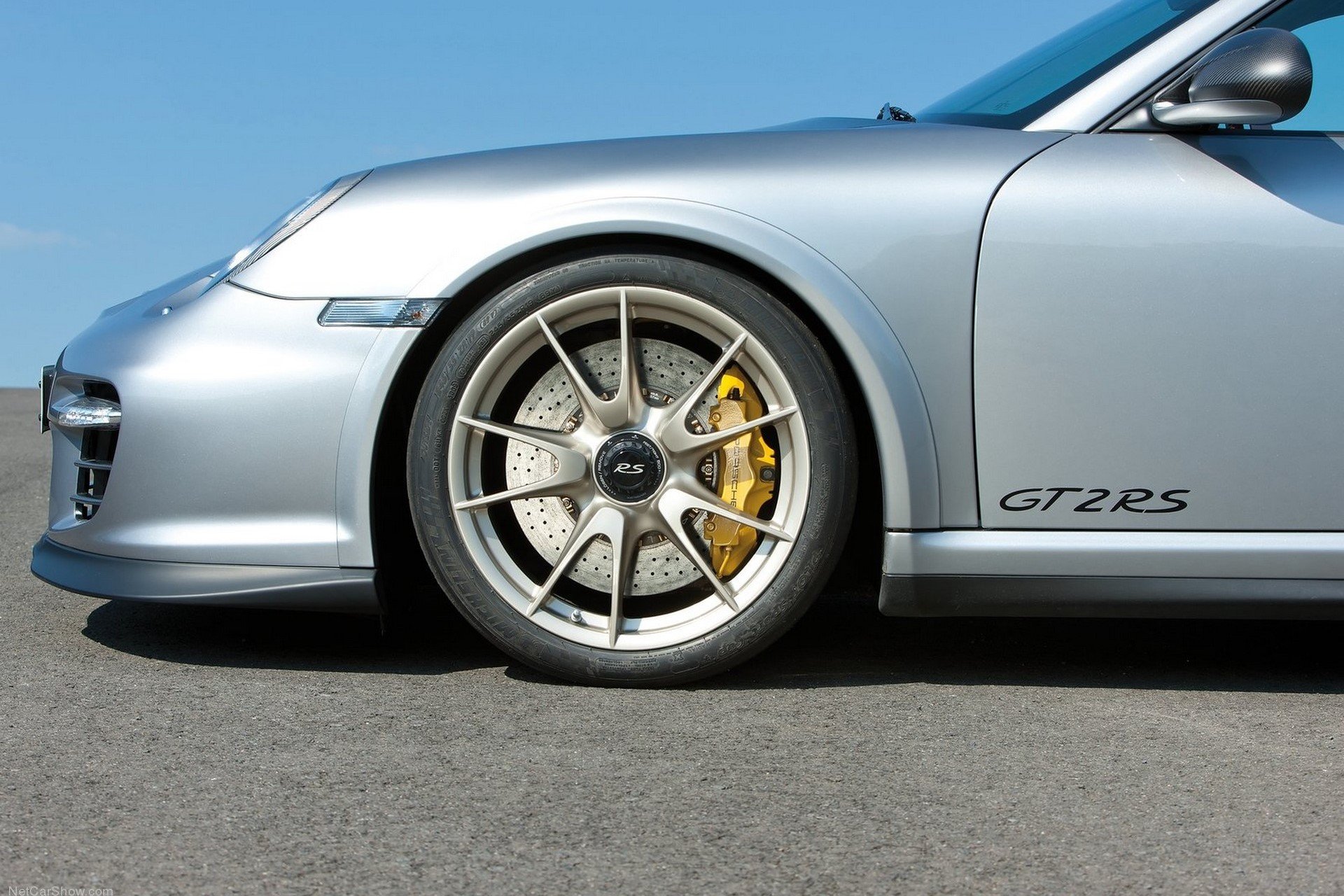
The main benefit of the PCCBs is their weight. Carbon-ceramic rotors weigh considerably less than steel, and by reducing unsprung weight, you improve steering and handling, increase throttle response, and shorten braking distances. It operates best when hot, so expect to hear some squealing when cold. That squealing is partially due to the rotor compound. It's a much harder material than steel and more durable, allowing it to withstand extreme temperatures and abuse
If you primarily drive on the street, it’s not unheard of for brake discs to last long. How long strictly depends on vehicle use and its frequency. You’ll also notice that this brake system produces less dust when driven modestly. Using this brake package on the track as intended will significantly reduce the life of the rotors, and when the time comes to replace them, the cost for parts alone is in the thousands of dollars (per rotor). For those reasons, it’s popular among track regulars to convert their PCCB brakes to a steel kit since the replacement costs are much more economical.
Porsche 997 Brake Service & Repair
The brakes on the 997 are as easy to service as those on a typical commuter car. Your 997 will also let you know when it’s time for service. One of the pad wear sensors will trip a warning light once the pad has worn down to a certain point. While you should heed the brake service warning, you won’t need to service them immediately. The warning indicates that around 1000 miles of brake pads are left, though exactly how much depends on the style of driving and the demands put on them.
Manufacturers like BMW and Mercedes use two pad wear sensors per vehicle, one on the front and one at the rear. Porsche uses four sensors, one mounted to each caliper. The monitoring of each caliper offsets the increased complexity and parts requirement. Typically, the fronts will wear together at a rate different from the rears due to the front-biased pressure. However, if there is an issue with one of the calipers, the individual sensors will alert you of the potential problem. At around $8 a sensor, it’s an inexpensive security blanket for you and your brakes.
The brake pads fitted to the different calipers vary in thickness. Porsche specifies a minimum pad thickness of 3mm for the steel rotors and 2mm for the carbon ceramics. When replacing the pads, you’ll also find dampers on the backs of the pads. Porsche fitted the dampers to reduce the noise and vibration from the brakes during everyday use. They fit into the caliper’s piston and have a flat circular backing plate that uses an adhesive to stick to the back of the brake pad. Their necessity is a hotly debated topic, with people finding success without using them.
Judging when it’s time to replace the discs is trickier than the pads. Porsche specifies a disc replacement where pads wear substantially over time after just 2 mm has worn off the discs. While that doesn’t seem like much, they should last through at least two sets of OE-type pads before reaching replacement. Examine the rotors’ surface to get a general idea of their remaining lifespan. The pads don’t contact the disc’s outer edge, so a large lip will indicate a need for replacement.
Judging carbon-ceramic replacement thickness is even more challenging. The material that can withstand wear is highly durable but incredibly thin. Porsche specifies a replacement after just .5mm has worn off. However, that half a mm will take significantly longer to wear than steel rotors. You’ll have to be very careful during replacement, too. The slightest chip or crack in the disc is grounds for immediate replacement. Replacement costs are $6000-8000 per rotor, so many replace the carbon discs with steel.
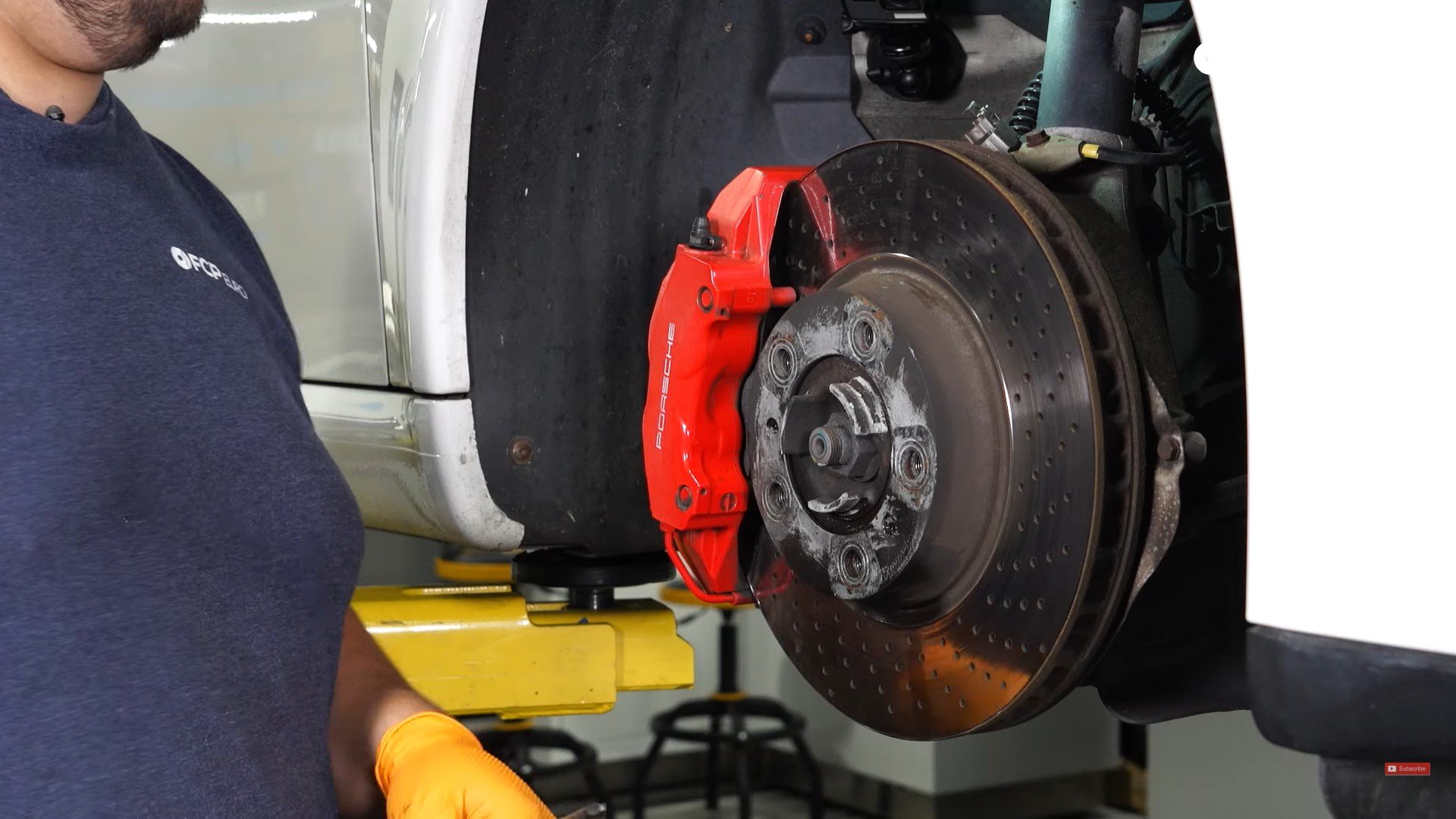
In extreme cases, the steel brake rotor can warp. The rotor will lose its perfectly flat friction surfaces if exposed to excessive heat for an extended period or when too much pad material becomes embedded in it. You’ll know when they become warped when the brakes make the whole car shudder at certain speeds. In most cases, a warped rotor isn’t the end of the world; instead, it’s an annoying reminder to change the discs.
There are two ways to solve a warped rotor: replacement or resurfacing. Depending on the severity of the warping, a machine shop can remove the top layer of material to re-flatten the surface. However, it’s easiest to replace them altogether.
Brake fluid also eventually needs replacing. Brake fluid absorbs water because of its chemical composition. Water in brake fluid significantly reduces the boiling point, weakening the fluid. As the fluid absorbs water, the brake pedal will become soft and spongy, giving you a poor response through the pedal. Porsche specifies a fluid flush every two years, though we recommend even sooner if your brakes see significant abuse.
Lastly, Porsche specifies that the caliper mounting bolts need replacing every time the caliper comes off. That may sound pointless, but the engineers in Stuttgart require it for a reason. Each caliper uses two bolts that go for around $5 each.
Porsche 997 Brake Compatibility
The easiest way to get larger brakes on the 997 is to replace them with larger OE brakes from a higher-performance model. However, it isn’t that simple. While the calipers may look the same and use similar-sized rotors and pads, the bolt spacing used to mount the caliper to the knuckle varies by model.
The base 997.1 Carrera uses the exact brakes from the 996.2. Because of that, they have a 130mm bolt spacing. Unfortunately, they are already the biggest caliper in the water-cooled Porsche lineup with 130mm bolt spacing. The knuckles would need to be swapped with those from an S variant or a base 997.2 Carrera to go any bigger. Both models and the 997.1 Turbo, GT3, and GT3RS use 142mm bolt spacing.
Upgrading the Carrera S brakes with the 142mm bolt spacing is much easier. The shared bolt spacing with the Turbo and .1 GTs allows their larger, six-piston calipers to bolt to the Carrera S knuckle with longer caliper mounting bolts. The larger calipers use a 20mm bigger rotor than the standard Carrera S, allowing for better heat dispersion and resistance. Only use the Turbo rotors with the six-piston calipers. They share the same hub offset as the Carrera, whereas the GT models use bespoke knuckles with corresponding rotors.
All models with the PCCBs and the .2 GT models use a larger 225mm bolt spacing. Their physically larger calipers use the larger spacing to help distribute the brake’s load more effectively into the knuckle from the larger 380mm rotors. Only these specific models can share caliper and rotor components.
Porsche 997 Brake Upgrades
The 997 is a competent chassis only aided by the available braking performance from any of the original calipers fitted to them. They work great in street applications but can use some help for more spirited purposes. For increased braking performance, non-OE parts are required, though not necessarily larger parts. Larger brakes don’t necessarily mean a reduced braking distance, and there is such a thing as too much brake. Instead, aftermarket pads, rotors, and stainless-braided brake lines should do the trick.
All non-PCCB models come equipped with cross-drilled steel rotors. They look cool and function well but are known to develop cracks when exposed to prolonged heat and abuse. Sebro offers a set of slotted rotors with high carbon content as a simple upgrade. The slots, versus the drilled holes, offer a better initial bite on the disc and a better evacuation of gasses between the rotor and pad. The higher carbon content in the alloy helps the rotor withstand more heat for a longer duration, preventing warping or cracking. These are excellent options for increased heat resistance required by spirited driving without getting into the motorsports-style parts.
Next up are the brake pads. Many companies make brake pads for the 997s in various pad compounds. Ferodo, Winmax, PFC, Hawk, and others offer pads ranging from aggressive street to autocross-specific to full-on endurance racing units. Most will be a high-concentration metallic compound. While providing a significant increase in initial bite, stopping power, and fade resistance, these pads have some downsides. The more aggressive the compound, the more dust it will produce. For those deeply invested in exterior cleanliness, the increase in dust may be a deciding factor. Other effects from the more aggressive pads are squealing and squeaking when cold or at slower speeds and a rapid rise in the rotor’s wear.
We’d recommend a set of stainless steel-braided brake hoses to go along with the increase in braking performance. Standard rubber lines can expand when exposed to extreme heat and pressure, reducing pad pressure. Stainless steel-braided lines cover the rubber lines, preventing expansion to deliver a consistent pedal feel. They are relatively inexpensive and can provide a nice safety blanket for your brake system.
Porsche 997 Track Ready Brake Parts
Spirited street driving and flat-out laps on a race track are not the same. Surviving and competing on a race track requires brake components to be kept at optimal operating temperatures for maximum effectiveness. Too much or too little heat will kill braking performance. Cold brakes generally aren’t an issue once they’re warmed up, so the key here is keeping the heat in check. Several components like larger, multi-piece rotors, cooling ducts, and the right pad compound will all lend themselves to repeated aggressive braking.
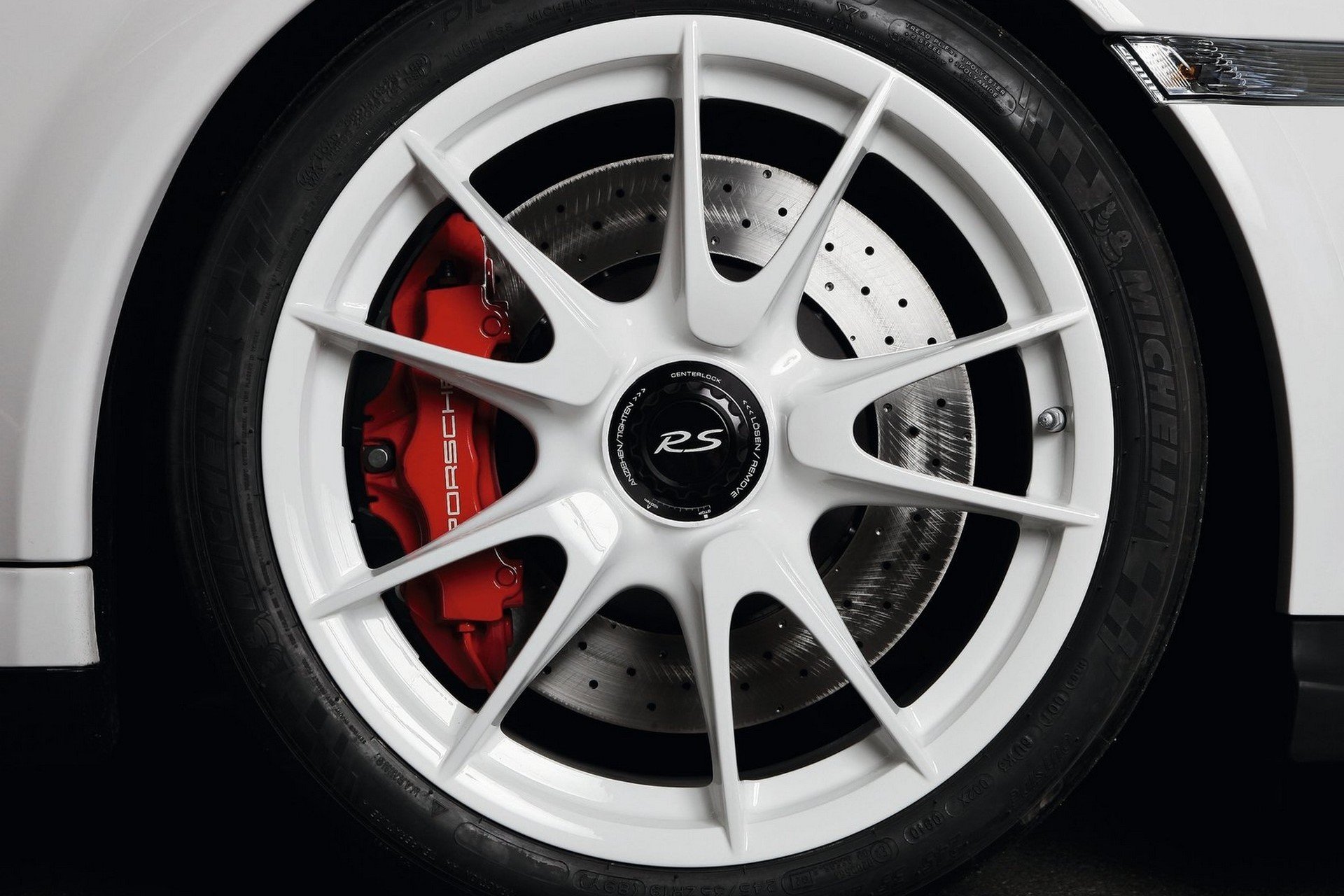
OEM rotors and the high-carbon Sebro pieces are single steel units with the hub formed to the disc. They work great for spirited driving, but their weight and lack of thermal durability handicap them in more serious roles. Companies like Girodisc, DBA, PFC, and Racing Brake offer upgraded rotors required to withstand repeated abuse. All of those discs are a multi-piece design. The two- and three-piece rotors use aluminum hats with replaceable steel or carbon rotor rings. The aluminum cuts a significant weight from the rotor and improves the resistance and dissipation of heat.
The Ferodo 2500 is a fine dual-purpose street and track day option. Paired with a good set of rotors, sufficient cooling, and high-temp fluid, they will handle light track days and drives to the beach. More aggressive pads will take the abuse from wheel-to-wheel action but come with significant tradeoffs. The dusting from the pad wear will cover the car, not just the wheels, and those pads will chew through rotors significantly quicker. Additionally, the pads and rotors will cost quite a bit more than street-friendly components. However, their effectiveness is enough to outweigh any negatives.
Lastly, you won’t be stopping any time soon without the right brake fluid. Repeated aggressive braking generates significant heat, and brake fluid, like any fluid, has a boiling point. Not all fluids are the same, so you’ll want to find one with a high boiling point. Any choices we offer, the Liqui Moly 20156, Motul RBF660, or the Castrol SRF, will work on the street and in a dedicated track car.
Porsche 997 Big Brake Kits
Instead of piecing together your braking system, you can grab a big brake kit for a one-stop performance upgrade. Several aftermarket companies offer options besides what could be considered “OEM Big Brake Kits,” like fitting Turbo calipers to a Carrera S. Brembo, Stoptech, AP Racing, and Alcon all offer these complete kits for the 997. However, their outright cost can offset their impact.
The smallest big brake kits from StopTech and Brembo include a two-piece rotor not much larger than the Turbo’s, their proprietary pads, stainless-braided lines, and four-piston calipers. Both start right around the $3500 mark for the fronts only. These are the cheapest options you’ll find. Genuine endurance racing brakes from Brembo and Alcon command upwards of $15,000 for complete caliper and rotor kits. Factory components can work just as well for less money when fitted with the right bits.
Special Tools Needed For Porsche 997 Brake Repair/Service
Porsche doesn’t require any extraordinary tools for brake service. The same tools you use for every other brake job work in this application. Replacing the pads and rotors is a simple DIY job that any owner can complete at home with the correct instructions. Have the tools below handy to make the brake service quick and smooth.
Porsche 997 Brake Torque Specifications
- Brake Caliper Bolt: 63 ft-lbs (85Nm)
- The brake caliper bolts are one-time-use and need replacement whenever you remove the brake caliper. Use a 10mm hex bit socket to remove and install the caliper bolts.
- Wheel Bolts: 95 ft-lbs (130Nm)

